Baby Names for a Sloth What Is a Female Sloth Called
| Sloths[1] Temporal range: Early Oligocene to Holocene | |
|---|---|
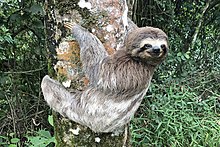 | |
| Bradypus variegatus, a three-toed sloth | |
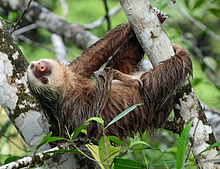 | |
| Choloepus hoffmanni, a 2-toed sloth | |
| Scientific classification | |
| Kingdom: | Animalia |
| Phylum: | Chordata |
| Class: | Mammalia |
| Superorder: | Xenarthra |
| Order: | Pilosa |
| Suborder: | Folivora Delsuc, Catzeflis, Stanhope, and Douzery, 2001[2] |
| Families | |
| |
| Synonyms | |
| |
Sloths are a group of arboreal Neotropical xenarthran mammals, constituting the suborder Folivora. Noted for their slowness of motion, they spend nearly of their lives hanging upside downward in the trees of the tropical rainforests of South America and Fundamental America. They are considered to be almost closely related to anteaters, together making up the xenarthran order Pilosa.
There are 6 extant sloth species in two genera – Bradypus (iii–toed sloths) and Choloepus (2–toed sloths). Despite this traditional naming, all sloths really have iii toes on each rear limb, although two-toed sloths have simply two digits on each forelimb.[iii] The two groups of sloths are from different, distantly related families, and are thought to have evolved their morphology via parallel evolution from terrestrial ancestors. Besides the extant species, many species of basis sloths ranging up to the size of elephants (like Megatherium) inhabited both Due north and S America during the Pleistocene Epoch. However, they became extinct during the Fourth extinction outcome effectually 12,000 years ago, together with nigh large bodied animals in the New World. The extinction correlates in time with the inflow of humans, but climatic change has also been suggested to have contributed. Members of an endemic radiations of Caribbean sloths formerly lived in the Greater Antilles. They included both ground and arboreal forms which became extinct after humans settled the archipelago in the mid-Holocene, around 6,000 years ago.
Sloths are so named considering of their very low metabolism and deliberate movements. Sloth, related to tiresome, literally means "laziness," and their common names in several other languages (e.g. French paresseux) also mean "lazy" or similar. Their slowness permits their low-free energy diet of leaves and avoids detection past predatory hawks and cats that chase by sight.[3] Sloths are almost helpless on the ground, only are able to swim.[4] The shaggy coat has grooved hair that is host to symbiotic green algae which camouflage the brute in the trees and provide it nutrients. The algae also attend sloth moths, some species of which exist solely on sloths.[5]
Taxonomy and evolution
Sloths vest to the superorder Xenarthra, a group of placental mammals believed to have evolved in the continent of South America around lx million years ago.[6] One study found that xenarthrans bankrupt off from other placental mammals effectually 100 million years ago.[7] Anteaters and armadillos are also included amid Xenarthra. The primeval xenarthrans were arboreal herbivores with sturdy vertebral columns, fused pelvises, stubby teeth, and small brains. Sloths are in the taxonomic suborder Folivora[ii] of the order Pilosa. These names are from the Latin 'leaf eater' and 'hairy', respectively. Pilosa is i of the smallest of the orders of the mammal class; its only other suborder contains the anteaters.
The Folivora are divided into at least viii families, only ii of which have living species; the residuum are entirely extinct (†):[8]
- †Megalocnidae: the Greater Antilles sloths, a basal group that arose about 32 million years ago and became extinct about 5,000 years ago.[8]
- Superfamily Megatherioidea
- Bradypodidae, the three-toed sloths, contains iv extant species:
- The brownish-throated three-toed sloth is the most common of the extant species of sloth, which inhabits the Neotropical realm[1] [9] in the forests of South and Fundamental America.
- The pale-throated three-toed sloth, which inhabits tropical rainforests in northern South America. It is similar in advent to, and oftentimes confused with, the chocolate-brown-throated three-toed sloth, which has a much wider distribution. Genetic evidence indicates the two species diverged effectually vi one thousand thousand years agone.[10]
- The maned iii-toed sloth, now found but in the Atlantic Forest of southeastern Brazil.
- The critically endangered pygmy three-toed sloth which is endemic to the small-scale island of Isla Escudo de Veraguas off the coast of Panama.
- †Megalonychidae: ground sloths that existed for almost 35 meg years and went extinct nearly 11,000 years agone. This group was formerly thought to include both the ii-toed sloths and the extinct Greater Antilles sloths.
- †Megatheriidae: ground sloths that existed for about 23 one thousand thousand years and went extinct about 11,000 years ago; this family unit included the largest sloths.
- †Nothrotheriidae: ground sloths that lived from approximately 11.six meg to xi,000 years ago. Also every bit ground sloths, this family included Thalassocnus, a genus of either semiaquatic or fully aquatic sloths.
- Bradypodidae, the three-toed sloths, contains iv extant species:
- Superfamily Mylodontoidea
- Choloepodidae, the ii-toed sloths, contains two extant species:
- Linnaeus'southward ii-toed sloth establish in Venezuela, the Guianas, Colombia, Ecuador, Republic of peru, and Brazil northward of the Amazon River.
- Hoffmann'due south two-toed sloth which inhabits tropical forests. It has 2 divide ranges, split up by the Andes. One population is found from eastern Honduras[11] in the north to western Ecuador in the south, and the other in eastern Republic of peru, western Brazil, and northern Bolivia.[12]
- †Mylodontidae: ground sloths that existed for about 23 million years and went extinct virtually 11,000 years agone.
- †Scelidotheriidae: collagen sequence data indicates this group is more distant from Mylodon than Choloepus is, then it has been elevated dorsum to total family status.[8]
- Choloepodidae, the ii-toed sloths, contains two extant species:
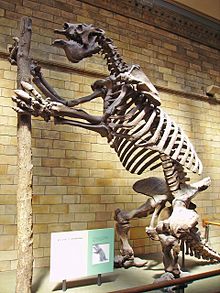
Evolution

The mutual ancestor of the 2 existing sloth genera dates to well-nigh 28 one thousand thousand years agone,[8] with similarities between the two- and three- toed sloths an example of convergent development to an arboreal lifestyle, "one of the most striking examples of convergent development known among mammals".[thirteen] The ancient Xenarthra included a much greater variety of species, with a wider distribution, than those of today. Ancient sloths were mostly terrestrial, and some reached sizes that rival those of elephants, as was the case for Megatherium.[4]
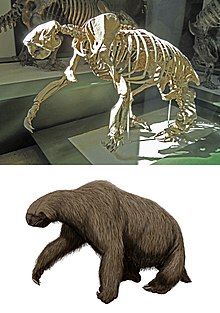

Sloths arose in South America during its long menses of isolation and somewhen spread to a number of the Caribbean islands too as Due north America. It is thought that swimming led to oceanic dispersal of pilosans to the Greater Antilles by the Oligocene, and that the megalonychid Pliometanastes and the mylodontid Thinobadistes were able to colonise Northward America almost nine 1000000 years ago, well before the formation of the Isthmus of Panama. The latter evolution, virtually 3 meg years agone, allowed megatheriids and nothrotheriids to also invade Northward America as part of the Slap-up American Interchange. Additionally, the nothrotheriid Thalassocnus of the west declension of Due south America became adapted to a semiaquatic and, somewhen, perhaps fully aquatic marine lifestyle.[xiv] In Peru and Chile, Thalassocnus entered the littoral habitat kickoff in the tardily Miocene. Initially they only stood in the water, but over a span of 4 million years they eventually evolved into swimming creatures, becoming specialist bottom feeders of seagrasses, similar to extant marine sirenians.[xv]
Both types of extant tree sloth tend to occupy the same forests; in nigh areas, a item species of the somewhat smaller and generally slower-moving three-toed sloth (Bradypus) and a single species of the two-toed blazon will jointly predominate. Based on morphological comparisons, it was thought the two-toed sloths nested phylogenetically within one of the divisions of the extinct Greater Antilles sloths.[16] Though information has been nerveless on over 33 unlike species of sloths by analyzing bone structures, many of the relationships between clades on a phylogenetic tree were unclear.[17] Much of the morphological show nerveless to support the hypothesis of diphyly has been based on the structure of the inner ear.[18]
Recently obtained molecular data from collagen[8] and mitochondrial Dna sequences[xix] fall in line with the diphyly (convergent development) hypothesis, merely accept overturned some of the other conclusions obtained from morphology. These investigations consistently place two-toed sloths close to mylodontids and 3-toed sloths inside Megatherioidea, close to Megalonyx, megatheriids and nothrotheriids. They make the previously recognized family Megalonychidae polyphyletic, with both two-toed sloths and Greater Antilles sloths being moved away from Megalonyx. Greater Antilles sloths are now placed in a split up, basal branch of the sloth evolutionary tree.[eight] [19]
Phylogeny
The following sloth family unit phylogenetic tree is based on collagen and mitochondrial Dna sequence data (see Fig. four of Presslee et al., 2019).[8]
| Folivora |
| |||||||||||||||||
Extinctions
The marine sloths of South America's Pacific coast became extinct at the stop of the Pliocene following the endmost of the Central American Seaway; this caused a cooling tendency in the littoral waters which killed off much of the area's seagrass (and which would have also made thermoregulation hard for the sloths, with their tedious metabolism).[20]
Ground sloths disappeared from both North and Southward America presently after the advent of humans well-nigh xi,000 years agone. Evidence suggests human hunting contributed to the extinction of the American megafauna. Basis sloth remains found in both N and S America betoken that they were killed, cooked, and eaten past humans.[iv] Climate change that came with the end of the final ice age may have besides played a part (although previous like glacial retreats were not associated with similar extinction rates).
Megalocnus and another Caribbean sloths survived until almost v,000 years ago, long subsequently basis sloths had died out on the mainland, but then went extinct when humans finally colonized the Greater Antilles.[21]
Biology
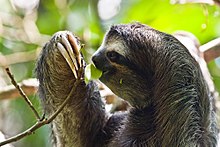
Morphology and anatomy
Sloths tin exist 60 to 80 cm (24 to 31 in) long and, depending on the species, counterbalance from 3.6 to seven.7 kg (7.ix to 17.0 lb). Two-toed sloths are slightly larger.[22] Sloths have long limbs and rounded heads with tiny ears. Three-toed sloths also have stubby tails nigh v to 6 cm (ii.0 to two.iv in) long.
Sloths are unusual amid mammals in not having seven cervical vertebrae. Two-toed sloths accept v to vii, while three-toed sloths have eight or 9. The other mammals not having seven are the manatees, with half dozen.[23]
Physiology
Sloths have colour vision, but have poor visual acuity. They also have poor hearing. Thus, they rely on their sense of odour and impact to detect food.[24]
Sloths have very low metabolic rates (less than half of that expected for a mammal of their size), and depression torso temperatures: thirty to 34 °C (86 to 93 °F) when agile, and still lower when resting. Sloths are heterothermic, meaning their torso temperature may vary according to the environment, normally ranging from 25 to 35 °C (77 to 95 °F), but able to drop to equally low equally 20 °C (68 °F), inducing torpor.[24]
The outer hairs of sloth fur grow in a direction opposite from that of other mammals. In almost mammals, hairs grow toward the extremities, but because sloths spend then much time with their limbs to a higher place their bodies, their hairs grow away from the extremities to provide protection from the elements while they hang upside downwards. In most atmospheric condition, the fur hosts symbiotic algae, which provide cover-up[25] from predatory jaguars, ocelots,[26] and harpy eagles.[27] Because of the algae, sloth fur is a small ecosystem of its own, hosting many species of commensal and parasitic arthropods.[28] There are a big number of arthropods associated with sloths. These include biting and blood-sucking flies such every bit mosquitoes and sandflies, triatomine bugs, lice, ticks and mites. Sloths have a highly specific community of commensal beetles, mites and moths.[29] The species of sloths recorded to host arthropods include[29] the stake-throated three-toed sloth, the chocolate-brown-throated three-toed sloth, and Linnaeus's ii-toed sloth. Sloths benefit from their relationship with moths because the moths are responsible for fertilizing algae on the sloth, which provides them with nutrients.[thirty]
Action
Their limbs are adjusted for hanging and grasping, not for supporting their weight. Muscles make up only 25 to 30 percent of their full body weight. Nearly other mammals have a muscle mass that makes upward 40 to 45 percent of their total trunk weight.[31] Their specialised hands and feet have long, curved claws to permit them to hang upside downward from branches without effort,[32] and are used to drag themselves along the footing, since they cannot walk. On three-toed sloths, the arms are 50 percent longer than the legs.[24]
Sloths move only when necessary and even then very slowly. They usually move at an boilerplate speed of four metres (13 ft) per minute, just can move at a marginally higher speed of 4.v metres (15 ft) per minute if they are in immediate danger from a predator. While they sometimes sit on top of branches, they commonly consume, sleep, and even requite nascency hanging from branches. They sometimes remain hanging from branches fifty-fifty afterward decease. On the ground, the maximum speed of sloths is iii metres (ix.eight ft) per minute. Two-toed sloths are more often than not better able than three-toed sloths to disperse betwixt clumps of copse on the basis.[33]
Sloths are surprisingly strong swimmers and can accomplish speeds of thirteen.five metres (44 ft) per minute.[34] They use their long artillery to paddle through the h2o and tin can cross rivers and swim betwixt islands.[35] Sloths can reduce their already slow metabolism even further and tedious their heart rate to less than a third of normal, assuasive them to hold their breath underwater for up to forty minutes.[36]
Wild brown-throated three-toed sloths sleep on average 9.6 hours a day.[37] 2-toed sloths are nocturnal.[38] 3-toed sloths are generally nocturnal, only can be active in the twenty-four hours. They spend 90 per cent of their time motionless.[24]
Beliefs
Sloths are solitary animals that rarely interact with one another except during breeding season,[39] though female sloths do sometimes congregate, more than so than practise males.[xl]
Nutrition

Infant sloths acquire what to eat by licking the lips of their mother.[41] All sloths consume the leaves of the cecropia.
Ii-toed sloths are omnivorous, with a diverse diet of insects, carrion, fruits, leaves and modest lizards, ranging over up to 140 hectares (350 acres). Three-toed sloths, on the other paw, are about entirely herbivorous (institute eaters), with a limited diet of leaves from but a few copse,[39] and no other mammal digests its food as slowly.
They take made adaptations to arboreal browsing. Leaves, their main food source, provide very little free energy or nutrients, and do not digest easily, and so sloths have large, boring-acting, multi-chambered stomachs in which symbiotic bacteria break downwards the tough leaves.[39] Every bit much as two-thirds of a well-fed sloth'southward body weight consists of the contents of its tummy, and the digestive process can accept a calendar month or more to complete.
Three-toed sloths go to the ground to urinate and defecate about once a week, digging a hole and covering it afterwards. They go to the same spot each time and are vulnerable to predation while doing and then. Because the large energy expenditure and dangers involved in the journey to the ground, this behaviour has been described as a mystery.[42] [43] [44] Recent research shows that moths, which live in the sloth's fur, lay eggs in the sloth's carrion. When they hatch, the larvae feed on the feces, and when mature fly upwardly onto the sloth higher up. These moths may accept a symbiotic human relationship with sloths, every bit they live in the fur and promote growth of algae, which the sloths eat.[5] Private sloths tend to spend the bulk of their time feeding on a single "modal" tree; by burying their excreta near the trunk of that tree, they may besides assist nourish it.
Reproduction
The stake- and brown-throated three-toed sloths mate seasonally, while the maned iii-toed sloth breeds at any fourth dimension of the yr. The reproduction of pygmy three-toed sloths is unknown. Litters are of 1 newborn only, afterward six months' gestation for three-toed, and 12 months' for two-toed. Newborns stay with their female parent for nigh five months. In some cases, young sloths dice from a fall indirectly because the mothers testify unwilling to leave the safety of the trees to retrieve the young.[46] Females usually acquit i baby every year, just sometimes sloths' depression level of move really keeps females from finding males for longer than ane year.[47] Sloths are non particularly sexually dimorphic and several zoos accept received sloths of the wrong sex.[48] [49]
The average lifespan of two-toed sloths in the wild is currently unknown due to a lack of full-lifespan studies in a natural environment.[50] Median life expectancy in human care is about 16 years, with i individual at the Smithsonian Institution's National Zoo reaching an historic period of 49 years before her death.[51]
Distribution
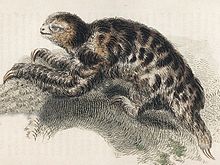
Although habitat is express to the tropical rainforests of Key and Due south America, in that environment sloths are successful. On Barro Colorado Isle in Panama, sloths have been estimated to comprise 70% of the biomass of arboreal mammals.[52] Four of the six living species are presently rated "least concern"; the maned three-toed sloth (Bradypus torquatus), which inhabits Brazil's dwindling Atlantic Wood, is classified every bit "vulnerable",[53] while the island-dwelling pygmy 3-toed sloth (B. pygmaeus) is critically endangered. Sloths' lower metabolism confines them to the torrid zone and they prefer thermoregulation behaviors of cold-blooded animals such as sunning themselves.[54]
Human being relations
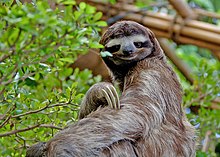
The bulk of recorded sloth deaths in Costa Rica are due to contact with electrical lines and poachers. Their claws also provide another, unexpected deterrent to homo hunters; when hanging upside-down in a tree, they are held in place by the claws themselves and ofttimes do non fall down even if shot from below.
Sloths are victims of creature trafficking where they are sold as pets. However, they make very poor pets, as they have such a specialized ecology.[55]
The founder and managing director of the Dark-green Heritage Fund Suriname, Monique Puddle, has helped rescue and release more than 600 sloths, anteaters, armadillos, and porcupines.[56]
The Sloth Establish Costa Rica is known for caring, rehabilitating and releasing sloths back into the wild.[57] Also in Costa Rica, the Aviarios Sloth Sanctuary cares for sloths. It has rehabilitated and released about 130 individuals back into the wild.[58] All the same, a report in May 2016 featured 2 former veterinarians from the facility who were intensely critical of the sanctuary's efforts, accusing it of mistreating the animals.[59]
References
- ^ a b Gardner, A. (2005). Wilson, D.Due east.; Reeder, D.M. (eds.). Mammal Species of the World: A Taxonomic and Geographic Reference (tertiary ed.). Johns Hopkins University Press. pp. 100–101. ISBN978-0-8018-8221-0. OCLC 62265494.
- ^ a b Delsuc, Frédéric; Catzeflis, François Thou.; Stanhope, Michael J.; Douzery, Emmanuel J. P. (7 Baronial 2001). "The evolution of armadillos, anteaters and sloths depicted by nuclear and mitochondrial phylogenies: implications for the status of the enigmatic fossil Eurotamandua". Proceedings of the Royal Society of London B: Biological Sciences. 268 (1476): 1605–1615. doi:ten.1098/rspb.2001.1702. ISSN 0962-8452. PMC1088784. PMID 11487408.
- ^ a b "Overview". The Sloth Conservation Foundation. Retrieved 29 November 2017.
- ^ a b c The State and Wildlife of South America . Time Inc. 1964. pp. 15, 54.
- ^ a b Bennington-Castro, Joseph. "The Strange Symbiosis Between Sloths and Moths". Gizmodo . Retrieved 1 December 2017.
- ^ O'Leary, Maureen A.; Bloch, Jonathan I.; Flynn, John J.; Gaudin, Timothy J.; Giallombardo, Andres; Giannini, Norberto P.; Goldberg, Suzann L.; Kraatz, Brian P.; Luo, Zhe-11 (eight February 2013). "The Placental Mammal Antecedent and the Post–Chiliad-Pg Radiation of Placentals". Science. 339 (6120): 662–667. Bibcode:2013Sci...339..662O. doi:ten.1126/science.1229237. hdl:11336/7302. ISSN 0036-8075. PMID 23393258. S2CID 206544776.
- ^ Svartman, Marta; Stone, Gary; Stanyon, Roscoe (21 July 2006). "The Bequeathed Eutherian Karyotype Is Present in Xenarthra". PLOS Genetics. 2 (7): e109. doi:10.1371/journal.pgen.0020109. ISSN 1553-7404. PMC1513266. PMID 16848642.
- ^ a b c d e f g Presslee, S.; Slater, G. J.; Pujos, F.; Forasiepi, A. M.; Fischer, R.; Molloy, Thousand.; Mackie, M.; Olsen, J. V.; Kramarz, A.; Taglioretti, Yard.; Scaglia, F.; Lezcano, One thousand.; Lanata, J. Fifty.; Southon, J.; Feranec, R.; Bloch, J.; Hajduk, A.; Martin, F. M.; Gismondi, R. South.; Reguero, Grand.; de Muizon, C.; Greenwood, A.; Chait, B. T.; Penkman, K.; Collins, M.; MacPhee, R.D.East. (2019). "Palaeoproteomics resolves sloth relationships" (PDF). Nature Ecology & Evolution. iii (7): 1121–1130. doi:x.1038/s41559-019-0909-z. PMID 31171860. S2CID 174813630.
- ^ Gardner, Alfred Fifty. (2007). "Suborder Folivora". In Gardner, Alfred 50. (ed.). Mammals of Due south America, Volume 1: Marsupials, Xenarthrans, Shrews, and Bats. Chicago: University of Chicago Press. pp. 157–168 (p. 161). ISBN978-0-226-28240-4.
- ^ Moraes-Barros, Chiliad.C.; et al. (2011). "Morphology, molecular phylogeny, and taxonomic inconsistencies in the written report of Bradypus sloths (Pilosa: Bradypodidae)". Journal of Mammalogy. 92 (one): 86–100. doi:10.1644/10-MAMM-A-086.1.
- ^ Plese, T.; Chiarello, A. (2014). "Choloepus hoffmanni". IUCN Red List of Threatened Species. 2014: e.T4778A47439751. doi:10.2305/IUCN.U.k..2014-1.RLTS.T4778A47439751.en.
- ^ Hayssen, V. (2011). "Choloepus hoffmanni (Pilosa: Megalonychidae)". Mammalian Species. 43 (1): 37–55. doi:x.1644/873.1.
- ^ Gaudin, T.J. (one February 2004). "Phylogenetic relationships among sloths (Mammalia, Xenarthra, Tardigrada): the craniodental evidence". Zoological Periodical of the Linnean Order. 140 (2): 255–305. doi:10.1111/j.1096-3642.2003.00100.10. ISSN 0024-4082.
- ^ Muizon, C. de; McDonald, H. G.; Salas, R.; Urbina, One thousand. (June 2004). "The evolution of feeding adaptations of the aquatic sloth Thalassocnus". Journal of Vertebrate Paleontology. 24 (2): 398–410. doi:x.1671/2429b. JSTOR 4524727. S2CID 83859607.
- ^ Amson, E.; Muizon, C. de; Laurin, M.; Argot, C.; Buffrénil, V. de (2014). "Gradual accommodation of os construction to aquatic lifestyle in extinct sloths from Peru". Proceedings of the Regal Society B: Biological Sciences. 281 (1782): 20140192. doi:x.1098/rspb.2014.0192. PMC3973278. PMID 24621950.
- ^ White, J.L.; MacPhee, R.D.E. (2001). "The sloths of the West Indies: a systematic and phylogenetic review". In Woods, C.A.; Sergile, F.Eastward. (eds.). Biogeography of the West Indies: Patterns and Perspectives. Boca Raton, London, New York, and Washington, D.C.: CRC Printing. pp. 201–235. doi:10.1201/9781420039481-14. ISBN978-0-8493-2001-9.
- ^ Gaudin, Timothy (2004). "Phylogenetic Relationships amidst Sloths (Mammalia, Xenarthra, Tardigrada): The Craniodental Show". Zoological Journal of the Linnean Society. 140 (2): 255–305. doi:10.1111/j.1096-3642.2003.00100.x.
- ^ Raj Pant, Sara; Goswami, Anjali; Finarelli, John A (2014). "Complex body size trends in the development of sloths (Xenarthra: Pilosa)". BMC Evolutionary Biological science. fourteen: 184. doi:10.1186/s12862-014-0184-1. PMC4243956. PMID 25319928.
- ^ a b Delsuc, F.; Kuch, M.; Gibb, Thousand. C.; Karpinski, Eastward.; Hackenberger, D.; Szpak, P.; Martínez, J. G.; Mead, J. I.; McDonald, H. G.; MacPhee, R.D.Eastward.; Billet, K.; Hautier, L.; Poinar, H. N. (2019). "Ancient Mitogenomes Reveal the Evolutionary History and Biogeography of Sloths". Current Biological science. 29 (12): 2031–2042.e6. doi:10.1016/j.cub.2019.05.043. PMID 31178321.
- ^ Amson, E.; Argot, C.; McDonald, H. G.; de Muizon, C. (2015). "Osteology and functional morphology of the axial postcranium of the marine sloth Thalassocnus (Mammalia, Tardigrada) with paleobiological implications". Journal of Mammalian Evolution. 22 (4): 473–518. doi:ten.1007/s10914-014-9280-7. S2CID 16700349.
- ^ Steadman, D. W.; Martin, P. S.; MacPhee, R. D. E.; Jull, A. J. T.; McDonald, H. G.; Woods, C. A.; Iturralde-Vinent, 1000.; Hodgins, G. West. L. (16 August 2005). "Asynchronous extinction of tardily Quaternary sloths on continents and islands". Proc. Natl. Acad. Sci. USA. 102 (33): 11763–11768. Bibcode:2005PNAS..10211763S. doi:10.1073/pnas.0502777102. PMC1187974. PMID 16085711.
- ^ "Sloth". National Geographic. March 2014. Retrieved 1 December 2017.
- ^ "Sticking their necks out for development: Why sloths and manatees take unusually long (or short) necks". ScienceDaily . Retrieved 26 April 2019.
- ^ a b c d "Sloth". Encyclopedia Britannica . Retrieved 1 December 2017.
- ^ Suutari, Milla; Majaneva, Markus; Fewer, David P.; Voirin, Bryson; Aiello, Annette; Friedl, Thomas; Chiarello, Adriano Thousand.; Blomster, Jaanika (one January 2010). "Molecular show for a diverse green algal community growing in the hair of sloths and a specific association with Trichophilus welckeri(Chlorophyta, Ulvophyceae)". BMC Evolutionary Biology. 10: 86. doi:10.1186/1471-2148-10-86. ISSN 1471-2148. PMC2858742. PMID 20353556.
- ^ Moreno, Ricardo S.; Kays, Roland Due west.; Samudio, Rafael (24 Baronial 2006). "Competitive Release in Diets of Ocelot (Leopardus pardalis) and Puma (Puma concolor) after Jaguar (Panthera onca) Decline". Periodical of Mammalogy. 87 (four): 808–816. doi:10.1644/05-MAMM-A-360R2.1. ISSN 0022-2372.
- ^ Aguiar-Silva, F. Helena; Sanaiotti, Tânia One thousand.; Luz, Benjamim B. (1 March 2014). "Food Habits of the Harpy Eagle, a Peak Predator from the Amazonian Rainforest Canopy". Periodical of Raptor Research. 48 (1): 24–35. doi:ten.3356/JRR-13-00017.1. ISSN 0892-1016. S2CID 86270583.
- ^ Gilmore, D. P.; Da Costa, C. P.; Duarte, D. P. F. (1 January 2001). "Sloth biology: an update on their physiological ecology, beliefs and role as vectors of arthropods and arboviruses". Brazilian Journal of Medical and Biological Research. 34 (one): 9–25. doi:10.1590/S0100-879X2001000100002. ISSN 0100-879X. PMID 11151024.
- ^ a b Gilmore, D. P.; Da Costa, C. P.; Duarte, D. P. F. (2001). "Sloth biology: an update on their physiological ecology, behavior and part as vectors of arthropods and arboviruses" (PDF). Brazilian Journal of Medical and Biological Research. 34 (ane): nine–25. doi:x.1590/S0100-879X2001000100002. ISSN 1678-4510. PMID 11151024.
- ^ Ed Yong (21 Jan 2014). "Can Moths Explain Why Sloths Poo on the Ground?". Phenomena.
- ^ "What Does It Hateful to Be a Sloth?". natureinstitute.org . Retrieved 29 June 2017.
- ^ Mendel, Frank C. (1 January 1985). "Use of Hands and Feet of Three-Toed Sloths (Bradypus variegatus) during Climbing and Terrestrial Locomotion". Journal of Mammalogy. 66 (2): 359–366. doi:ten.2307/1381249. JSTOR 1381249.
- ^ Garcés‐Restrepo, One thousand.F.; Pauli, J.N.; Peery, M.Z. (2018). "Natal dispersal of tree sloths in a human-dominated mural: Implications for tropical biodiversity conservation". Journal of Practical Ecology. 55 (five): 2253–2262. doi:10.1111/1365-2664.13138.
- ^ Goffart, M. (1971). "Function and Form in the sloth". International Serial of Monographs in Pure and Applied Biology. 34: 94–95.
- ^ BBC (4 Nov 2016), Swimming sloth - Planet Globe 2: Islands Preview - BBC One, archived from the original on 30 October 2021, retrieved 17 Apr 2017
- ^ Britton, South. W. (1 Jan 1941). "Form and Office in the Sloth". The Quarterly Review of Biology. sixteen (1): 13–34. doi:ten.1086/394620. JSTOR 2808832. S2CID 85162387.
- ^ Briggs, Helen (xiii May 2008). "Article "Sloth'due south Lazy Paradigm 'A Myth'"". BBC News. Retrieved 21 May 2010.
- ^ Eisenberg, John F.; Redford, Kent H. (xv May 2000). Mammals of the Neotropics, Volume iii: The Central Neotropics: Ecuador, Peru, Republic of bolivia, Brazil. University of Chicago Printing. pp. 624 (see pp. 94–95, 97). ISBN978-0-226-19542-1. OCLC 493329394.
- ^ a b c Alina Bradford (26 November 2018). "Sloths: The Globe's Slowest Mammals". Alive Scientific discipline.
- ^ "Sloth". Animate being Corner.
- ^ Venema, Vibeke (4 April 2014). "The adult female who got 'slothified'". BBC News . Retrieved 1 December 2017.
- ^ "The 'Busy' Life of the Sloth | BBC World". YouTube. xviii May 2009. Retrieved 11 February 2022.
- ^ "The greatest mystery of sloth pooping has been solved". 23 January 2014.
- ^ "Welcome to the United states Petabox". Archived from [Title:A syndrome of mutualism reinforces the lifestyle of a sloth Authors:Jonathan N. Pauli, Jorge Eastward. Mendoza, Shawn A. Steffan, Cayelan C.Carey, Paul J. Weimer and Grand. Zachariah Peery Periodical:Proceedings of the Imperial Guild B the original] on fifteen July 2013.
- ^ Soares, C. A.; Carneiro, R. S. (ane May 2002). "Social behavior between mothers × young of sloths Bradypus variegatus SCHINZ, 1825 (Xenarthra: Bradypodidae)". Brazilian Periodical of Biology. 62 (2): 249–252. doi:10.1590/S1519-69842002000200008. ISSN 1519-6984. PMID 12489397.
- ^ Pauli, Jonathan North.; Peery, M. Zachariah (19 Dec 2012). "Unexpected Stiff Polygyny in the Brownish-Throated Three-Toed Sloth". PLOS ONE. 7 (12): e51389. Bibcode:2012PLoSO...751389P. doi:10.1371/journal.pone.0051389. ISSN 1932-6203. PMC3526605. PMID 23284687.
- ^ "Manly secret of not-mating sloth at London Zoo". BBC News. BBC. nineteen Baronial 2010. Retrieved 30 April 2015.
- ^ "Aforementioned-sex sloths dash Drusillas breeding plan". BBC News. BBC. 5 December 2013. Retrieved 30 April 2015.
- ^ "About the Sloth". Sloth Conservation Foundation . Retrieved 31 October 2019.
- ^ "Southern two-toed sloth". Smithsonian's National Zoo. 25 April 2016. Retrieved 30 October 2019.
- ^ Eisenberg, John F.; Redford, Kent H. (xv May 2000). Mammals of the Neotropics, Book 3: The Central Neotropics: Ecuador, Peru, Republic of bolivia, Brazil. Academy of Chicago Printing. pp. 624 (run across p. 96). ISBN978-0-226-19542-1. OCLC 493329394.
- ^ Chiarello, A. & Moraes-Barros, Northward. (2014). "Bradypus torquatus". IUCN Red List of Threatened Species. 2014: eastward.T3036A47436575. doi:10.2305/IUCN.United kingdom of great britain and northern ireland.2014-i.RLTS.T3036A47436575.en.
- ^ Dowling, Stephen (29 August 2019). "Why do sloths movement so slowly?". BBC Future. BBC News. Retrieved 2 September 2019.
- ^ "Sloths: Hottest-Selling Animate being in Republic of colombia'south Illegal Pet Trade". ABC News. 29 May 2013. Retrieved 2 December 2017.
- ^ "When sloths are in problem, she'due south the i to telephone call". CNN . Retrieved 1 December 2017.
- ^ "The Sloth Institute website".
- ^ Sevcenko, Melanie (17 April 2013). "Sloth sanctuary nurtures animals back to health". Deutsche Welle . Retrieved eighteen April 2013.
- ^ Schelling, Ameena (19 May 2016). "Famous Sloth Sanctuary Is A Nightmare For Animals, Ex-Workers Say". The Dodo . Retrieved 20 May 2016.
External links
verbrugghentheacted.blogspot.com
Source: https://en.wikipedia.org/wiki/Sloth